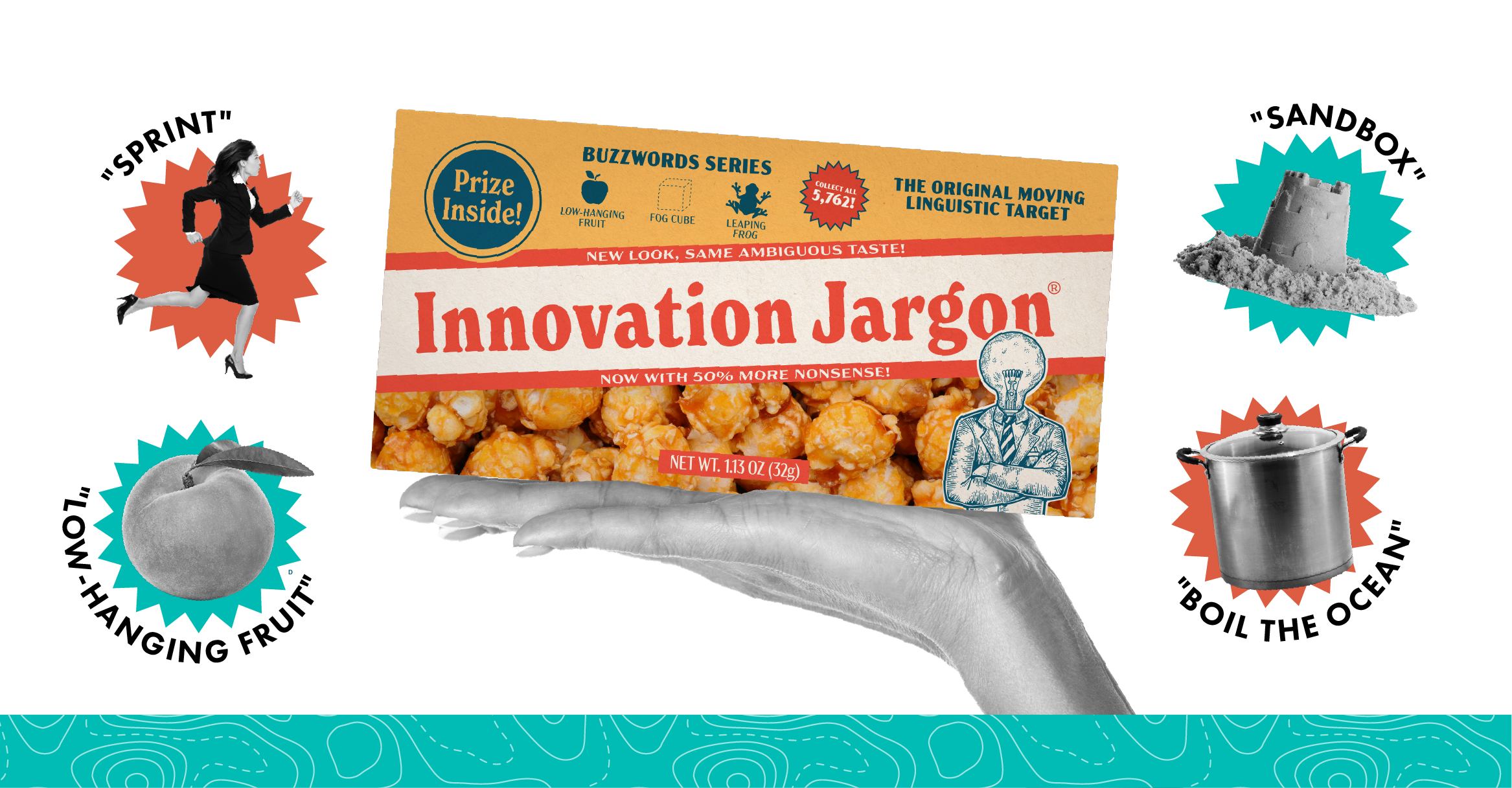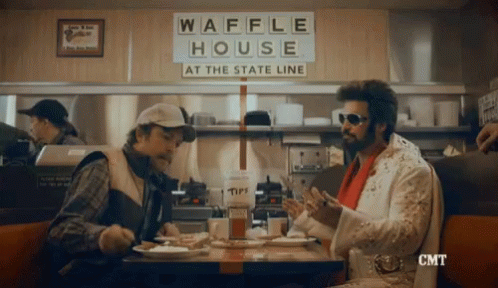
Cracker Jack Gems of Innovation Jargon

Innovation jargon: it's what's for breakfast. But this breakfast is a little bit like eating at Waffle House. You want some cheese on your hash browns? You'll have to say "covered." Onions? "Smothered." In order to get the breakfast you actually want, you have to consult a (literal) translation chart.
Now imagine that it's not just breakfast at stake, but the future of your company. And there are hundreds of toppings on a menu that just keeps getting bigger, and someone keeps playing “Sweet Home Alabama” on the jukebox.

For now, maybe we should just stick with a cup of very-unambiguous coffee and work through the complications around innovation and how it's being discussed. We can eat after.
The Problem
Currently, businesses of all sizes and across all industries have departments and/or initiatives dedicated to driving innovation. Progress is a beautiful but challenging thing, so naturally these teams are whip-smart and savvy and full of amazing ideas!
However, the ideas themselves are not the main currency. Before the organization is bought in, the thinking behind the ideas has to be marketed. Ideas generated need to be translated and turned into new brand strategies, directions and actions for marketing, research and development, product development and other departments. So as the saying goes, “Naming is framing” - assigning language and jargon to innovation is an embedded part of building culture and gaining buy-in for new ideas.
And therein lies one of the funniest problems we face in innovation: different teams don’t always speak the same innovation language. One of the biggest barriers to the process of innovation is the ambiguity in language and jargon surrounding it. For anyone who has been tasked with innovation or anyone being held to KPIs involving innovation, it can often be challenging to align on a shared definition of the very things you are trying to accomplish or measure. You can certainly look up "Agile" on Google, and you'll get a definition that uses the word "agile". But what does agile mean for your team? And for the organization more broadly?
Language is a critical part of how culture is built. Shared language is a part of how people accomplish goals and connect with one another. But even if you have experience with the language of innovation in one context, it varies greatly from company to company, and person to person. This makes the use of innovation jargon a moving target. So how did we get here? Why is everything so wiggly?
It's New and it’s Changing
It's important to note that the quantifiable "innovation department" is a relatively new concept. As Harvard Business Review writes, "It is also hard to remember that before the 1980s, very little in the way of empirical evidence existed as to what companies should expect when they ventured into new territory."
From its inception, corporate innovation has been carried out as a sort of performance art. There's an element of "spectacle" involving showmanship and theater, folded into expensive workshops or retreats. Imagine a pizza party with 15 presentation boards, where people are tossing around a koosh ball and speaking solely in acronyms. "Gosh," they said as they sat down in a bright green beanbag chair. "Look at all the trappings of creativity surrounding us! It'd be nearly impossible to innovate if some global catastrophe prevented us from being in this room together." [pandemic enters dramatically]
Guess what didn't disappear during the pandemic lockdown? Innovation. In fact, by virtue of necessity, businesses were (and still are) hella innovative in addressing a complete paradigm shift for their employees, clients, and processes. We already knew it, but this was the concrete proof that the innovation process is not dictated by its own ephemera. The shift also highlighted a limitation of the existing process: speed. In the time it takes to plan a workshop and collect all the post-its and supplies needed to unlock creativity, the specific problems being addressed by the innovation may have already changed two or three times.
Innovation as a business objective is still kind of new, and still very much evolving. But the relative new-ness isn't the only problem surrounding how we discuss innovation. As the activities and procedures evolved, the language around them also evolved. There are two key elements to why language continuously evolves: to keep its relevance or freshness, and to help teams or brands cultivate a sense of ownership over their process.
The Cycle of Relevance + Individual Business Contextual Significance
Relevance: It's hard to sound credible as an innovation expert when you're using 30-year-old buzzwords. This type of specialized jargon has a turning point - an expiration date - where it loses relevance and runs the risk of becoming cliche. Innovation terminology has many holdovers. Often, instead of getting archived, the cliches get revived or re-contextualized and brought back after a lull. Even in the cases where the authors of these phrases are found and publicly lambasted, the mental associations have already been made and there is no way back. Disruption, by true definition, is exceedingly rare. When we peel back the language around a company's broad goal of "disruption," we may find that what they're really trying to attain is closer to micro-innovation, or creating a discomfort in their competitors.
Ownership: Getting back to the breakfast train: have you ever ordered a "McMuffin" at a Hardee’s drive through? The shame of it. Businesses tend to put their own stamp on products and procedures, and with that, their own language. As similar as the processes may be, the terminology describing them can vary drastically. This is not a bad thing. Language shapes reality, and branded innovation jargon helps teams get buy-in and sell processes within their own organizations. It can build excitement. Additionally, the use of specific language can be very revealing to the story of innovation culture within teams, and what solutions will work best for them.
And to be clear, nobody's adding words to the innovation lexicon to intentionally create confusion. It's happening organically, and largely by necessity.

To help illustrate what we're discussing, we have compiled a non-comprehensive list of innovation jargon, with an open-invitation to help us add to the list.
If you take one thing from this, let it be this: If you hear any of these words, one of the first things you might need to do is ask what they mean to the person speaking them. Something as simple as "concept testing" could be a $500k project with stage gates or it could be a lean $20k test where you interact with 5 users. The main goal could be to develop an “MVP”... which could be a “Minimal Viable Prototype” of duct tape and foam core or it could be a “Minimum Viable Product” - a full-fidelity, launch and go-to-market ready offering. These subtle differences in words and meaning can change the entire intent of the initiative.

Brainstorming
Innovation (with a capital "I")
innovation (this one has a lowercase "i")
Ideation Session
Disruption
Boil the Ocean
Cutting Cubes out of Fog
Iterate

Low-Hanging Fruit
Leapfrogging

Co-Creation
Open Innovation
Crowdsourcing
Divine Intervention (fake but valid)

(By color)
Blue Ocean
Red Ocean
White Space
(By landscape)
Horizons
Upstream
Downstream
Waterfall
Terrain
Territory
Roadmap

Crawl/Walk/Run
Step/Stretch/Leap
Sprint
Incremental Innovation
Phase-Gate Process

Sandbox
Incubator
Concept Testing
Pressure Testing

Minimum Viable Prototype
Minimum Viable Product
Minimum Viable Experience
Minimum Viable Interaction

Jobs To Be Done
Play-To-Win Strategy Canvas
Ten Types of Innovation
The Future of Innovation
Words and jargon only hold the meanings they are assigned, and not everybody agrees on those meanings. Taking the time to understand context and intention is always a good idea. We've been in this field for over 20 years, and we have extensive experience and interaction with the concepts and terms - and we STILL prioritize clarity. For those with less experience, the future of innovation will be centered around education and learning.

There is an entire new generation now entering the field, whose formative introduction to the innovation process was experienced over Zoom calls or on Miro. For many of us, innovation was practiced in-person: in meetings, workshops, in hallway conversations and on white-boards: modalities many of us in the field were deprived of for a couple years. Some will be experiencing active workshops and in-person innovation sessions for the first time and teams will need to continue evaluating internal innovation processes, and the frameworks and jargon that comes with, to ensure that they are still delivering results and not falling back into theatrics that ignore the customer reality.
But remember: At the end of the day it doesn't matter what language you use. The only language that REALLY matters is your user’s language. Don’t let the internal jargon you use to innovate disconnect you from understanding the problem that needs to be solved.

